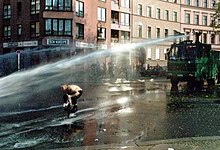Chain of posts
A chain of posts describes a guard duty , especially in the military and the police , the purpose of which is, in general, to protect an area against "penetration" by opposing persons, e.g. B. to secure enemy soldiers , demonstrators , or similar.
A chain of posts can be open or closed
Open chain of posts
Open chains of posts are used in particular when a large area with relatively few personnel has to be secured against relatively few people.
It is sufficient that every soldier or general guard can see a certain area.
Examples of the use of open post chains are, for example, in the military field when securing the main battle line or when guarding the border , if a massive onslaught of people is not to be expected, but isolated attempts at penetration (e.g. illegal border crossings). In the National Socialist concentration camps , too , open chains of guards were used to guard the prisoners.
Closed chain of posts
Closed post chains are used when a relatively small area has to be secured against a relatively large number of people. A relatively large number of people are deployed on the short section to keep the chain of posts tight.
Examples of the use of closed chains of posts are police barriers during demonstrations, where it must be expected that masses of demonstrators will start a concentrated attempt to break through. This type of control chain is also known as “ crowd and riot control ”.
Chains of posts in concentration camps
In the National Socialist concentration camps , chains of posts were used as an instrument to murder and terrorize prisoners.
The guards formed an open chain of posts to secure the workplace. Terrorism, for example beatings or service dogs , which were hounded on the prisoners, forced them to run into the chain of guards, where they were shot "while trying to escape".
literature
- Federal Ministry of Defense (Ed.): Central service regulation of the Bundeswehr - ZDv 75/100 The military police officers of the Bundeswehr . Bonn.
- Sören Sünkler: The special units of the Bundeswehr . 2nd Edition. Motorbuch-Verlag, Stuttgart 2007, ISBN 978-3-613-02592-9 .
- Reinhard Scholzen: Feldjäger: Germany's military police today . Motorbuch, Stuttgart 2010, ISBN 978-3-613-03152-4 .
- Herrmann Langbein: People in Auschwitz . S. Fischer Verlag, Frankfurt am Main 2016, ISBN 3-596-31086-5 .
